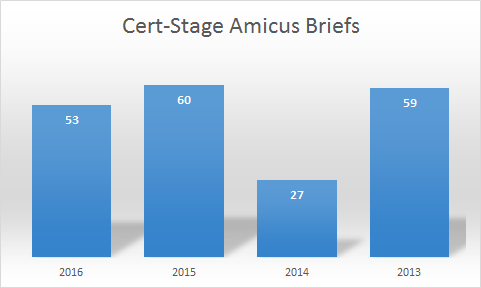
When, soon after his nomination to the Supreme Court, Judge Garland was praised for his judicial restraint, this praise was not envisioned for the type of impact Judge Garland’s nomination has made on the Court so far. Similarly, no one calling for judicial restraint or decrying the Court’s judicial activism prior to 2016 expected change to come in the form it has.
Nonetheless, avid Court watchers and scholars are beginning to note that forced judicial restraint may be a byproduct of an evenly divided Court, especially one that is split along ideological lines.
Justice Roberts, however, did not bring up the unfilled seat on the Court as an influential factor when he described the Court’s judicial restraint this past May. By contrast, other Justices, acknowledge direct effects from this Court’s current composition.
In this election year, the Supreme Court vacancy has usurped a good deal of the political conversation (ironically, judicial restraint is a deeply rooted political concept although it is predicated on the separation of powers and not on intra-Court dynamics). Those in favor of a more restrained judiciary, may see this jurisprudential philosophy effectuated in more ways than merely in the Court’s merits decisions. A second manner in which this coerced restraint may become evident is through the Court’s choices of cases to take on cert.
As there are very few cases on the Court’s mandatory docket the Justices decide on how many cases they hear each Term and on which cases to take. The Justices’ lack of decisiveness in several important cases last Term including in Zubik, U.S. v. Texas, and Friedrichs may play a role in their decisions to avoid politically charged, contentious cases this coming Term.
If the Court is constrained from within, the repercussions may be more than those just immediately visible. For instance, if the Court takes fewer or avoids certain cases, such decisions may lead to momentum along a path that the Court of the future finds difficult to slow. There are signs that the Court has been less willing to take on new cases since the vacancy was left by Justice Scalia. While the Court is still granting fewer cases than it has in past years at least through the summer recess, this differential is not as substantial as it portended to be earlier this past Term.
A few other indicia point towards the Court’s avoidance of political and polarizing cases. National news coverage is one mechanism that conveys the importance of cases to the general population. The cases granted so far this Term have garnered much less of this type of attention than cases granted by August 1 over the past several Terms. To do this analysis I looked at cases discussed in four major periodicals – the New York Times, Wall Street Journal, Washington Post, and USA Today – the day after the Court granted cert. This year three cases were discussed by one such periodical and two cases were discussed in two.
| Trinity Lutheran Church of Columbia, Inc. v. Pauley | 2 |
| Moore v. Texas | 2 |
| Samsung Electronics Co. v. Apple | 1 |
| Bethune-Hill v. Virginia State Board of Elections | 1 |
| Star Athletica, LLC v. Varsity Brands | 1 |
These seven points of coverage fall far behind the thirteen in 2015.
| Fisher v. University of Texas at Austin | 3 | |
| Friedrichs v. California Teachers Association | 3 | |
| Evenwel v. Abbott | 2 | |
| Hurst v. Florida | 2 | |
| Harris v. Arizona Independent Redistricting Commission | 1 | |
| Federal Energy Regulatory Commission v. Electric Power Supply Assn. | 1 | |
| Tyson Foods v. Bouaphakeo | 1 | |
They also do not come near the twelve points of coverage in 2014 or the fourteen in 2013.
| 2014 | |
| Elonis v. U.S. | 3 |
| Holt v. Hobbs | 2 |
| Zivotofsky v. Kerry | 2 |
| Alabama Democratic Conference v. Alabama | 1 |
| Teva Pharmaceuticals USA v. Sandoz | 1 |
| Integrity Staffing Solutions v. Busk | 1 |
| North Carolina Board of Dental Examiners v. FTC | 1 |
| Department of Homeland Security v. MacLean | 1 |
| 2013 | |
| McCutcheon v. Federal Election Commission | 4 |
| Town of Greece v. Galloway | 3 |
| Schuette v. Coalition to Defend Affirmative Action | 2 |
| National Labor Relations Board v. Noel Canning | 2 |
| Bond v. U.S. | 1 |
| Medtronic v. Mirowski Family Ventures, LLC | 1 |
| Mount Holly v. Mt. Holly Gardens Citizens in Action | 1 |
Another means of discerning early stage case importance is through cert-stage amicus filings. Although this does not convey the same type of generalized interest as news coverage, it does present interest beyond the parties prior to a cert grant. When looking at cases granted by August 1st over the last several Terms, there were only fewer cert-stage amicus briefs filed in 2014 than in 2016.

In 2015 and 2013 there was at least one case with more cert stage amicus briefs filed in it by August 1st than the cases with the most such filings this Term. So far in 2016 there are three granted cases with six cert-stage amicus briefs (Pena-Rodriguez v. Colorado, State Farm Fire and Casualty Co. v. United States ex rel. Rigsby, and Samsung Electronics Co. v. Apple). In 2015 there was a case with ten cert stage amicus briefs (Spokeo v. Robbins), another with nine (Friedrichs v. California Teachers Association), and one with eight (Fisher v. University of Texas at Austin). In 2013 the affirmative action case, Schuette v. Coalition to Defend Affirmative Action had seven such briefs. Surprisingly, even the cases with broad media coverage in 2014 such as Zivotofsky and Holt v. Hobbs garnered few cert-stage amicus briefs (one in the former and zero in the latter).
One final way that the Court’s restraint in selecting cases this Term is evident is through the cases the Court has decided to forgo. Although the Court traditionally does not grant petitions in all politically charged cases, the Court has decided to avoid cases that could clarify its rulings from the past several Terms. If this were another Term, this avoidance might be surprising, but it fits the pattern of the 2016 cert grants thus far.
The first such case where the Court denied cert was in Stormans Inc. v. Wiesman dealing with pharmacists that did not wish to dispense certain birth control. There were fourteen cert stage amicus briefs filed in Stormans. The Court also denied cert in Shew v. Malloy, a case challenging Connecticut’s ban on semiautomatic rifles and in a similar New York based case, Kampfer v. Cuomo. The Court declined to hear the abortion case Currier v. Jackson Women’s Health Organization where the appellate court struck down a law as unconstitutional that would have eliminated the only abortion clinic in Mississippi, as well as Nebraska and Oklahoma v. Colorado, which was a challenge on original jurisdiction to Colorado’s legalization of commercial growing and distribution of marijuana.
Finally, although the Court decided to hear two death penalty cases, Moore v. Texas and Buck v. Davis, so far in the 2016 Term, the Court declined to hear broader challenges to the death penalty. The Court denied cert in Tucker v. Louisiana which brought a general challenge against the constitutionality of the death under the Eight Amendment, and declined to grant cert for the second question in Moore dealing with whether leaving an inmate on death row for an extended period of time constitutes cruel and unusual punishment (although the Court appeared to initially grant cert on this question in Moore as well as on the first question dealing with the determination of intellectual disability).
The Justices still have many cert decisions to make for the 2016 Term. These decisions are likely to be influenced by whether or not the Senate holds confirmation proceedings for Judge Garland or delays until the next President is selected. As long as the Court is without a ninth member, we might expect the Justices’ to maintain their tentative stance towards new cases, especially those that might engender conflict and lead to evenly divided votes. When Judge Garland or someone else is confirmed to the vacant seat on the Court, the Justices will have a new force to help them overcome the Court’s current, inherent tension. Although the Justices only need four votes to grant cert in a given case, a number that they easily can satisfy today, this Court’s restrained posture on cert is not likely to change until the Court once again has more than double this number of members.
On Twitter: @AdamSFeldman
7 Comments Add yours